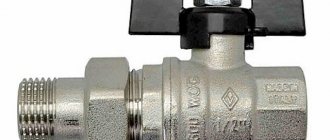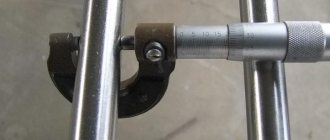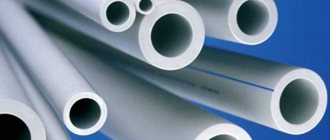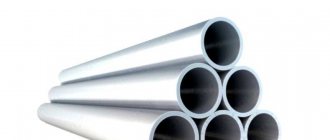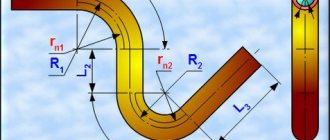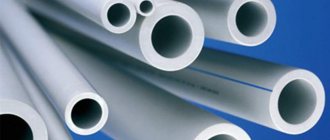Until you are faced with choosing a pipe, it seems that there is nothing complicated about it. There is a size, and you need to select the material according to it. That’s how it is, but you can measure it both inside and outside. So which measurement is correct? Oddly enough, both. There are standards according to which pipes are marked by outer size, and others that indicate the inner size. And the diameters of steel pipes are only available in a certain set. So, with the same outer diameter, we can have a pipe with different capacities and operating at different pressures.
Let's understand the terminology
Our country has a metric number system. And we measure everything in meters, centimeters and millimeters. Traditionally, the diameter of steel pipes is measured in millimeters. But the pipe has two diameters - internal and external, and is also characterized by wall thickness. So what diameter are we talking about when we talk about the size of steel pipes? Depends on the standard to which they are made. In some cases this means the outer diameter, in others the inner diameter. That's how difficult it is.
Diameters of steel pipes: which one to use
Nominal and nominal diameter
Pipes are used at different pressures. For a higher one, greater strength is required and this is achieved due to the wall thickness. In this case, the outer diameter of the pipe is left fixed. Otherwise, it will not be possible to connect the segments, and difficulties will arise with threads, fittings, etc. So the outer diameter is only an external parameter. Therefore, such a concept as conditional passage was introduced. In general, this is an outdated name and according to modern standards they say “nominal diameter”.
The nominal diameter of the pipe (nominal diameter) is a calculated value that is calculated during design. This value approximately corresponds to the internal diameter of the pipe in millimeters. Approximately, because the walls, with the same outer size, are of different thickness. This means that the clearance is changing. To somehow harmonize all this, a nominal diameter was introduced. This is a specific list of quantities defined by GOST 28338-89. They are shown in the table. Actual dimensions are rounded to the nearest nominal.
A number of standard nominal values of the nominal diameter of gas and water pipes and fittings for them
The designation of this value is DN, sometimes the Russian version is called Dn. After these letters there is a number without metric signs: DN30 or DN150. This is read as a nominal pipe diameter of 30 or 150, or a nominal diameter of 30 and 150. There are no units of measurement, since this is a conventional value.
Once again: all existing elements of water supply and gas pipeline systems are marked in accordance with the list of standard values - nominal diameters Dn. The actual size of the internal cross-section of a pipe or fitting may be larger or smaller. It is rounded to the nearest standard value.
In fact, the nominal diameter of a pipe or nominal size is a value that reflects the throughput. It is approximately equal to the inner diameter. After all, when you assemble a system, you use elements from different materials, with different wall thicknesses. Therefore, it is more reasonable to focus not on the diameters of the internal part, but on the nominal diameter. This will make it possible to ensure the same throughput of all elements of the system.
Which pipe is considered small - medium - large?
Even in serious sources I have seen phrases like: “We take any pipe of average diameter and...”, but no one indicates what this average diameter is.
To figure it out, you should first understand what diameter you need to focus on: it can be internal or external. The first is important when calculating the transport capacity of water or gas, and the second is important for determining the ability to withstand mechanical loads.
External diameters:
- From 426 mm is considered large;
- 102-246 is called average;
- 5-102 is classified as small.
As for the internal diameter, it is better to look at the special table (see above).
Diameters of steel pipes according to standard 3262-75
This document describes water and gas pipes (the common abbreviation VGP). They can be made of galvanized steel or regular steel. They can have a thread - short or long, the edge should be smooth, with a small amount of burrs (5%). The edge of the pipe without thread can be smooth or designed for welding - with a chamfer of 35-45°.
Steel pipes manufactured according to the GOST 3262-75 standard, with an equal outer diameter, can have three wall thicknesses. Depending on the wall thickness, the pipe is called:
- lightweight (the thinnest wall);
- ordinary (average in thickness);
- reinforced (the thickest).
Table of diameters of steel pipes GOST 3262-75
With equal outer diameter and different wall thickness, the inner diameter changes. But to avoid confusion, the concept of nominal bore or nominal diameter is used. Previously it was designated as Du, now it is correct to write DN. Sometimes it is believed that the nominal bore is equal to the internal diameter. Sometimes this is true, but not always. Rather, this happens very rarely. More often, the actual internal cross-section of the pipe is different - the walls are of different thicknesses. How to control the quality of a product? According to the correspondence of wall thickness and outer diameter.
How to check quality
Since the internal clearance can be different, you have to control the external dimensions and wall thickness. Thickness is more important. It must be measured at different points, at both ends of the pipe. Approximately this parameter can be tracked by the mass of a linear meter.
By the way, there can be considerable deviations in wall thickness. The standard allows deviations both upward and downward. If the diameter of steel pipes is no more than 40 mm, permitted deviations are up to 0.4 mm in the direction of increase and up to 0.5 mm in the direction of decrease. There are two categories of pipe production: regular and high precision. For products of increased precision, the deviation towards decreasing wall thickness is slightly less.
Permissible deviations for VGP
Examples of designations for pipes that are manufactured in accordance with this standard: pipe 20*2.8 GOST 3262-75. It should be read as a pipe with a standard diameter of 20 and a wall thickness of 2.8 mm. From the table you can determine that this is a pipe of normal strength with an outer diameter of 26.8 mm. There you can also find the approximate mass of a meter depending on the thickness of the walls.
How to deal with import designations
There are not only products from domestic manufacturers on the market. There are pipes marked according to the American system. Let's start with the fact that they distinguish between two types of pipes: pipes and tubes. Both words translate as pipe, but they are intended for different systems and the requirements for them are different.
Pipes type
Type of Pipes - electric welded and seamless. They are designed for transporting liquids and gases. So this is exactly the type that can be used in our heating and water supply systems. The main characteristic of pipes type pipes is the internal diameter. There are two strength standards in this group, which determines wall thickness and operating pressure.
- Schedule 40 or standard. The designation may include st (as in the figure below). These are products with standard wall thickness.
- Schedule 80 or extra heavy. The designation is EX. This is a material for use in high pressure pipelines.
Difference in internal diameters of Pipes of different strength categories: standard and heavy.
As you understand, with the same external size, the clearance will be different. Let's take a two-inch pipe as an example. It is designated as NPS=2″ internal diameter in different designs differs:
- standard (standard) schedule 40 - 2.067 inches (which is approximately equal to 5.25 cm);
- extra heavy schedule 80 - 1.939 inches (approximately 4.925 cm).
These categories standardize wall thickness and maximum operating pressure. The outer diameter remains constant, but the actual inner diameter changes with the wall thickness. That is, NPS=2″ describes the inside diameter, which will be about two inches, but will vary depending on the wall thickness. Here the situation is similar to our standards: there is a certain list of values to which actual parameters are rounded when labeling. Once again: if we are talking about a two-inch Pipe type pipe (the marking says NPS), you need to understand that we are talking about the internal diameter, but it will not be exactly two inches. It will be either a little more or a little less. Same with other sizes in inches.
Type Tubes
The word Tubes refers to pipes that are marked by outer diameter. The internal one will depend on the wall thickness. Therefore, this standard also contains the concept gauge, which can be translated as gauge. It just indicates the wall thickness.
The same diameters of steel pipes do not mean the same weight
The marking is marked with ASTM. The numbers following the abbreviation describe the outer diameter. In this group, we may be interested in copper pipes.
Correspondence table for pipe diameters in inches and millimeters
Let's say right away that pipes are measured not in ordinary inches, but in pipe inches. If a regular inch is 25.4 mm, then a pipe inch according to GOST is 33.249 mm . And pipes with such an outer diameter (or close to it) are usually called inch. But the internal diameter can vary greatly: the wall thickness of an inch pipe can be 2.5 mm, or it can be 8 mm. The correspondence of the nominal diameter in inches and millimeters is given in the table. Note! These are not outer/external size values. This corresponds to the nominal diameters of our standard and the DIN standard.
Correspondence table for nominal bore or nominal diameter of pipes in inches and millimeters
If you look at the correspondence table, you can see that when calculating the nominal diameter, the usual inch is used. We use pipe when it is necessary to convert the symbol into outer diameter. But even knowing the size of the pipe inch will not help to obtain the exact value of the outer diameter. It gives an approximate correspondence by which you can navigate. The exact details are shown in the table below.
Steel pipe diameters in inches, outside size in millimeters and nominal equivalent in our metric system
So, let's summarize. How to convert pipe dimensions in inches to centimeters and vice versa? If you convert Du into inches, you must divide by the usual inch and round the resulting number to the nearest standard. The diameters of steel pipes of common sizes are summarized in tables. If there is no table, the outer diameter can be calculated approximately using the “pipe inch”. We multiply the pipe size in inches by 33.249, we get a number close to the table value. Why not accurate? Because we are trying to convert the nominal (read - conditional) diameter into a real value - the external size. Therefore, the result is only close to the table.
Inch volume value
The cross section of the pipe, expressed in inches, is easy to decipher. Diameter is most often measured in inches. 3.35 centimeters corresponds to one unit. The decoding of the indicator is different because the product is measured by the diameter inside the pipe, and not outside.
For example, for a one-inch workpiece, the internal diameter varies from 2.55 to 2.71 centimeters. The thickness of the walls affects its size.
A one-inch pipe has an outside diameter of 25.4 millimeters, and a two-inch pipe has a diameter of 50 millimeters. What then do the numbers 33.249 or 66498 mean?
Threads on inch pipes are made on the outer volume. Thus, the internal volume and thread diameter are related conventionally. Therefore, the size of pipe products is calculated by adding the numbers 25.4 or 50 and two wall thicknesses of the product.
Reference! To correctly convert one value to another, measurements are taken from the inside. Because, based on external measurement data, the result will be incorrect and the installation will be performed incorrectly, since the pipes have different wall thicknesses.
It should be borne in mind that each manufacturer focuses on its own pipe manufacturing standards.
If difficulties arise in decoding, you should seek the help of professionals who will help you choose the necessary products.
How to measure pipe diameter
If you are not a professional plumber, you are unlikely to be able to determine the size of the pipe by eye. But you need to know this parameter, since the diameters of steel pipes are an important parameter. This value will be required, for example, when replacing a pipeline, installing new fittings, etc. You will need the diameter. It is easier to determine the wall thickness - most often it is 4 mm. Its parameters are sufficient for any household pipeline: water supply (cold or hot), heating. You can measure it on the saw cut. But if you check old pipes, it may well be that the walls have become thinner.
So, to determine the diameter of a pipe, the easiest way is to measure its cross section. If you have access to the cut, use a ruler or measuring tape. If there is no access to the cut, a drawing pen can help.
Measuring pipe diameter using improvised means
If you don’t have a drawing board, you will need a measuring tape or a flexible tape measure. You need to measure the circumference and write the resulting figure in millimeters. To calculate the diameter of the pipe, you need to divide this figure by 3.14 (the number π).
How to determine the diameter from the circumference
For example, you measured 4.4 cm, that is 44 mm. Divide this figure by 3.14, we get: 44/3.14 = 14 mm - this is the outer diameter of the pipe. We look at the table, which shows the diameters of steel pipes. Most likely, our pipe is 13.5 mm in diameter, with a nominal diameter of 8 mm. We attribute the slight discrepancy to measurement inaccuracy.
How to distinguish metric threads from inch threads
It is not difficult to distinguish an inch pipe from a metric one. To differentiate, you need to pay attention to the thread notches. It is almost impossible to determine the degree of notch by eye, especially since the difference between metric and inch threads is only 5 degrees.
Metric threads have a cut of 60 degrees, and inch threads have a cut of 55 degrees.
Pipelines can be distinguished by rounded threads, which are visible to the naked eye. It is impossible to make a mistake, but to clarify, a special device is used - a thread gauge. As a last resort, to clarify the thread, you can use an ordinary ruler. The photo below shows a special coupling, which is used to connect a plumbing product to a regular one.

